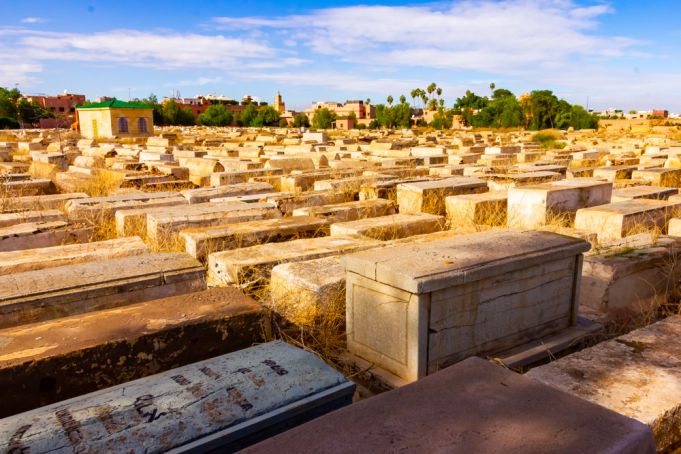Mellah Neighborhood
The Old Jewish Quarter in a primarily Islamic city is the district of Mellah.
This historic neighborhood was built in 1558 by Saadian sultans, bring diversity to the city. During the World War II, Saadian rule protected the quarter and the Moroccan Jewish population, during a fight against Vichy France.
The sultan leadership saved many important buildings and sites in Mellah that can still be visited today. Along with these historically Jewish attractions are other attractions, like the Bahia Palace and the spice markets.
The Mellah Spice Souk is one of the oldest spice markets in the district. Located at the edge of Mellah, locals and tourists alike can buy Moroccan saffron and ras el hanout, an exotic blend of more than 30 different ingredients.
With many vendors and a large supply of cumin, coriander and many other spices, the Mellah Spice Souk also sells a variety of other products. Here, customers can find medicinal herbs or plants, dried fruits, perfumes, soaps and luxurious fabrics.
Also read:
Not quite as old, but just as grand, as the Mellah Spice Souk is the Bahia Palace. Designed the Andalusian character, the palace was created by Minister Ahmed bin Musa in the 19th-century. Named after his wife, Bahia, the palace shares the secrets of the ancient world.
With a name meaning “brilliance,” the Bahia Palace and its surrounding gardens were intended to be the greatest of their time. Decorated with mosaics and tiles of intricate designs, the palace was meant to house offices for administrative business, family members, palace staff and a school for the minister’s children. It’s easy to get lost, in this magnificent work of art and architecture.
Despite these impressive attributes to Mellah, Jewish history is not lost in this district. The Neguidim Synagogue is one of many Jewish sites scattered throughout the neighborhood. Constructed in the 19th century, the synagogue consists of three parts. Upon entering the synagogue, visitors will pass through a small room reserved solely for women.
Beyond this room is a modest synagogue proper. The third room houses the wall of Sion, a tabernacle, with a carved arch against the western wall. The red earth that creates the floor is decorated with colored textiles and cushions. Between the wall of Sion and arch is a row of wooden seats.
Also read:
The Neguidim Synagogue is only one of many synagogues in the Mellah neighborhood, but it is not the only stable of the neighborhood. Built in the 20th-century, the Alzama Synagogue is one part of a series of buildings, expertly placed around the central patio.
The patio is decorated with paintings and zelliges refined to white and blue. The eastern wall of the patio is reserved only for women, a cultural innovation in Morocco that keeps women by the entrance to the synagogue or in a separate room. This is a cultural concept that is linked with mosques in Islam. Near this reserved room is a wooden arch, which gives way to a marble arch. Above the synagogue lies a yechiva, or soup kitchen, and a place for community services.
The Alzama Synagogue has painted walls and is not as luxuriously decorated as its counterpart, the Neguidim Synagogue.
Also read:
Besides synagogues, the neighborhood of Mellah has other significant Jewish sights, like the Miara Cemetery. Established in the 16th century, this cemetery is the only Jewish cemetery in city and the largest in Morocco.
Although the Jewish population in Marrakesh continues to dwindle, the Miara Cemetery is still in use. The entrance of the cemetery is marked by a large wooden door topped with a sign written in Hebrew. The cemetery is large with spaces designated solely for mourners and separate congregation halls.
There are three burial grounds within Miara, each designated for a specific group: men, women and children. In Jewish faith, it is customary for women to be buried apart from men. However, women can be buried next to their husbands.
Each tombstone is different, some are decorated with Hebrew scripts, while others are simply marked and flanked by candles. Some tombstones mark the lives of Jewish people coming from different countries, for example some mark lives of those that fled Spain during the Spanish inquisition.
Others are marked for Sephardic Jews, who relocated to Morocco from Andalusia. Being as though Miara Cemetery is the only Jewish cemetery in Marrakesh, there is limited space. The tombstones mark three layers of burial grounds.
All of these historic sits can be explored and cherished in the Old Jewish Quarter of Marrakesh, Mellah. The narrow streets will lead visitors to various spice markets and past intricate synagogues, providing a diverse experience from the typical Marrakesh.
General Info
View on Map
Mellah Neighborhood
Mellah, Marrakesh 40000, Morocco









